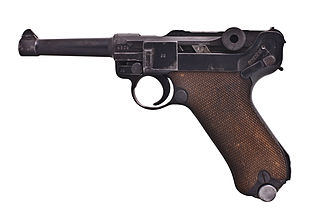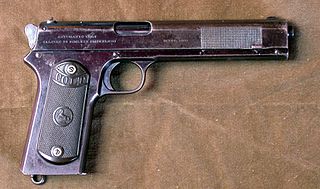Related Research Articles

The Pistole Parabellum or Parabellum-Pistole, commonly known as just the Luger or Luger P08, is a toggle-locked recoil-operated semi-automatic pistol. The Luger was produced in several models and by several nations from 1898 to 1949.

The Browning Hi-Power is a single-action, semi-automatic pistol available in the 9×19mm Parabellum and .40 S&W calibers. It was based on a design by American firearms inventor John Browning, and completed by Dieudonné Saive at FN Herstal. Browning died in 1926, several years before the design was finalized. FN Herstal named it the "High Power" in allusion to the 13-round magazine capacity, almost twice that of other designs at the time, such as the Walther P38 or Colt M1911.

The Colt M1911 is a single-action, recoil-operated, semi-automatic pistol chambered for the .45 ACP cartridge. The pistol's formal U.S. military designation as of 1940 was Automatic Pistol, Caliber .45, M1911 for the original model adopted in March 1911, and Automatic Pistol, Caliber .45, M1911A1 for the improved M1911A1 model which entered service in 1926. The designation changed to Pistol, Caliber .45, Automatic, M1911A1 in the Vietnam War era.

The Browning Automatic Rifle (BAR) is a family of American automatic rifles and machine guns used by the United States and numerous other countries during the 20th century. The primary variant of the BAR series was the M1918, chambered for the .30-06 Springfield rifle cartridge and designed by John Browning in 1917 for the American Expeditionary Forces in Europe as a replacement for the French-made Chauchat and M1909 Benét–Mercié machine guns that US forces had previously been issued.

A semi-automatic pistol is a handgun that automatically ejects and loads cartridges in its chamber after every shot fired. Only one round of ammunition is fired each time the trigger is pulled, as the pistol's fire control group disconnects the trigger mechanism from the firing pin/striker until the trigger has been released and reset.

The Colt Single Action Army is a single-action revolver handgun. It was designed for the U.S. government service revolver trials of 1872 by Colt's Patent Firearms Manufacturing Company and was adopted as the standard-issued pistol of the U.S. Army from 1873 to 1892.

The .45 ACP, also known as .45 Auto, .45 Automatic, or 11.43×23mm is a rimless straight-walled handgun cartridge designed by John Moses Browning in 1904, for use in his prototype Colt semi-automatic pistol. After successful military trials, it was adopted as the standard chambering for Colt's M1911 pistol. The round was developed due to a lack of stopping power experienced in the Moro Rebellion in places like Sulu. The issued ammunition, .38 Long Colt, had proved inadequate, motivating the search for a better cartridge. This experience and the Thompson–LaGarde Tests of 1904 led the Army and the Cavalry to decide that a minimum of .45 caliber was required in a new handgun cartridge.
The M1917 Browning machine gun is a heavy machine gun used by the United States armed forces in World War I, World War II, the Korean War, and the Vietnam War; it has also been used by other nations. It was a crew-served, belt-fed, water-cooled machine gun that served alongside the much lighter air-cooled Browning M1919. It was used at the battalion level, and often mounted on vehicles. There were two main iterations: the M1917, which was used in World War I and the M1917A1, which was used thereafter. The M1917, which was used on some aircraft as well as in a ground role, had a cyclic rate of 450 rounds per minute. The M1917A1 had a cyclic rate of 450 to 600 rounds per minute.

In American English, a pocket pistol is any small, pocket-sized semi-automatic pistol, and is suitable for concealed carry in a pocket or a similar small space.

The FN Model 1910 is a blowback-operated, semi-automatic pistol designed by John Browning and manufactured by Fabrique Nationale of Belgium.

The Colt Model 1903 Pocket Hammerless is a .32 ACP caliber, self-loading, semi-automatic pistol designed by John Browning and built by Colt Patent Firearms Manufacturing Company of Hartford, Connecticut. The Colt Model 1908 Pocket Hammerless is a variant introduced five years later in .380 ACP caliber. Despite the title "hammerless", the Model 1903 does have a hammer. The hammer is covered and hidden from view under the rear of the slide, this allows the pistol to be carried in and withdrawn from a pocket quickly and smoothly without snagging.

The Colt Model 1900 is a short-recoil operated "self-loading", or semi-automatic .38 caliber handgun introduced by Colt's Manufacturing Company at the turn of the 20th century. The M1900 was the first firearm to be chambered in .38 ACP and was the first handgun to utilize short-recoil operation.

The Colt Double Eagle is a double-action / single action, semi-automatic pistol manufactured by Colt's Manufacturing Company between 1989 and 1997. It was available in standard full-size, as well as in more compact versions. It featured a decocking lever, and was chambered for several calibers. The family of models was known as the Series 90.

The Model 1902 is a semi-automatic pistol developed by famous American firearms designer John Browning and produced by the Colt's Patent Firearms Manufacturing Company in the early 20th century. The Model 1902 was not a new design, but rather an incremental improvement upon the nearly identical M1900, and would transition from the 1900 into three distinct but related pistols with the same action and cartridge, the 1902 Sporting Model, the 1902 Military model, and the 1903 Pocket Hammer model. The 1902 Sporting model was so similar to the 1900 that it continued the serial number range, while the 1902 Military Model featured a different serial range as did the 1903 Pocket Hammer model. The 1902 Military Model featured a square and lengthened grip frame with an additional round in the magazine, while the 1903 Pocket Hammer featured a shortened barrel and slide but retained the Sporting model grip frame. The Colt M1905 .45 ACP pistol would be derived from the same lineage, also with a different serial number range.

The MEU(SOC) pistol, officially designated the M45 MEUSOC, is a magazine-fed, recoil-operated, single-action, semiautomatic pistol chambered for the .45 ACP cartridge. It is a variant of the M1911 for use by the Force Recon Element of the United States Marine Corps' Marine Expeditionary Units from 1985 until 2022. It is assigned NATO Stock Number 1005-01-370-7353.
The Taurus PT1911 is a replication of the US military model 1911 single-action recoil operated semi-automatic pistol. Designed in Porto Alegre, Brazil, it was initially distributed and released in the U.S. consumer market in the fall of 2005.
Llama Firearms, officially known as Llama-Gabilondo y Cia SA, was a Spanish arms company founded in 1904 under the name Gabilondo and Urresti. Its headquarters were in Eibar in the Basque Country, Spain, but they also had workshops during different times in Elgoibar and Vitoria. The company manufactured moderate-priced revolvers and self-chambering pistols in a wide variety of models. These were popular mainly in the European and Latin American export market, as well as domestically in Spain.

The Savage Model 1907 is a semi-automatic pocket pistol produced by the Savage Arms, from 1907 until 1920. It was chambered in .32 ACP and, from 1913 until 1920, in .380 ACP. Although smaller in size, it is derived from the .45 semi-automatic pistol Savage submitted to the 1906-1911 US Army trials to choose a new semi-automatic sidearm. After several years of testing the Savage pistol was one of two finalists but ultimately lost to the Colt entry, which became famous as the Colt Model 1911. A total of 181 of these .45 ACP pistols were returned to Savage after the testing and sold on the civilian market.

The Hamada Type 1 or Hamada Type Automatic handgun was a semi-automatic pistol developed starting in 1941 for use by the Empire of Japan during World War II. Developed by Bunji Hamada, the pistol took its basic design from the Model 1910 Browning. Production occurred at the Japanese Firearms Manufacturing Company, with only minor changes made as the war progressed.
The Colt Model 1909 was a prototype automatic pistol developed by John Browning for testing by the United States Army Ordnance Corps in 1909.